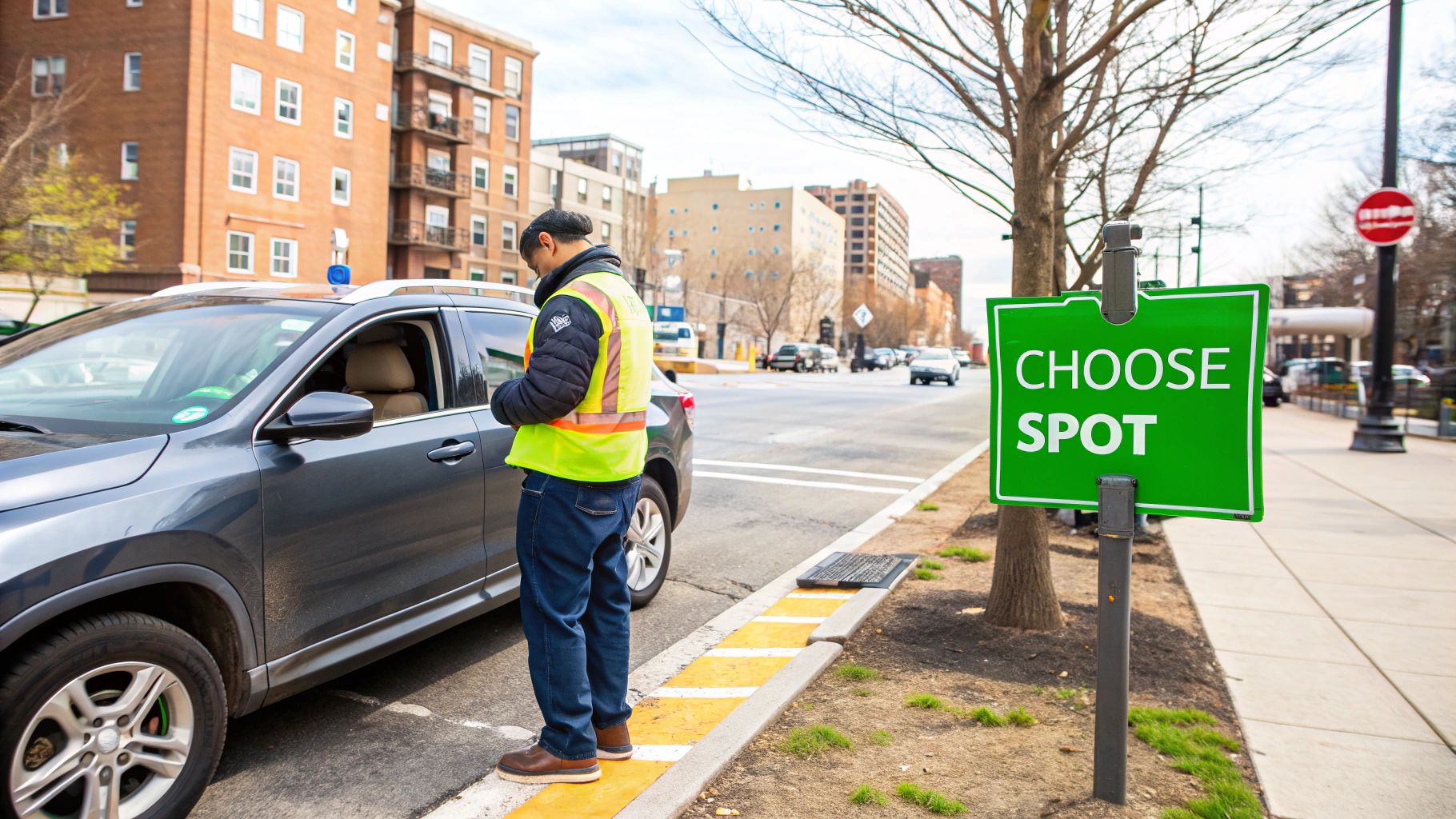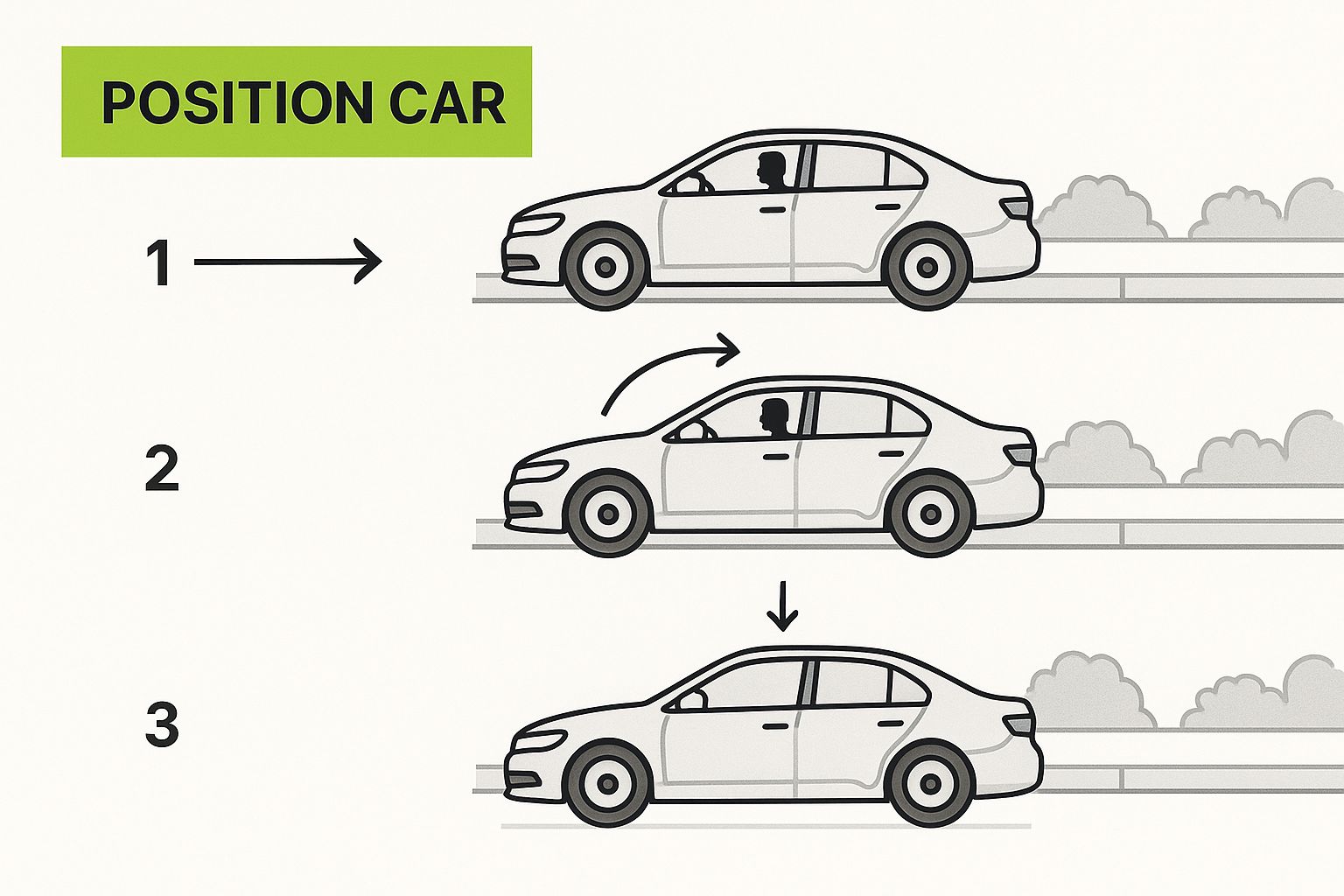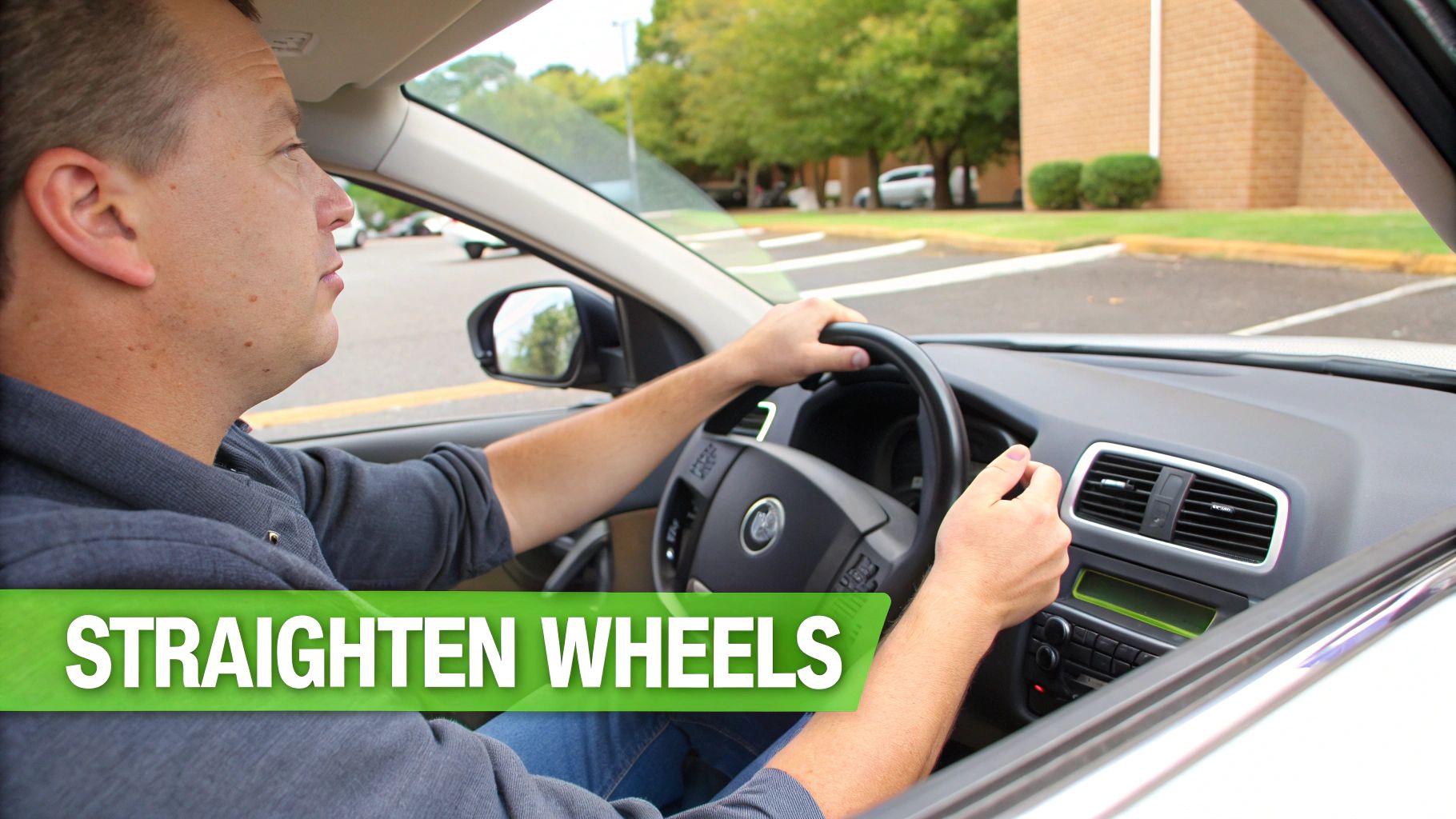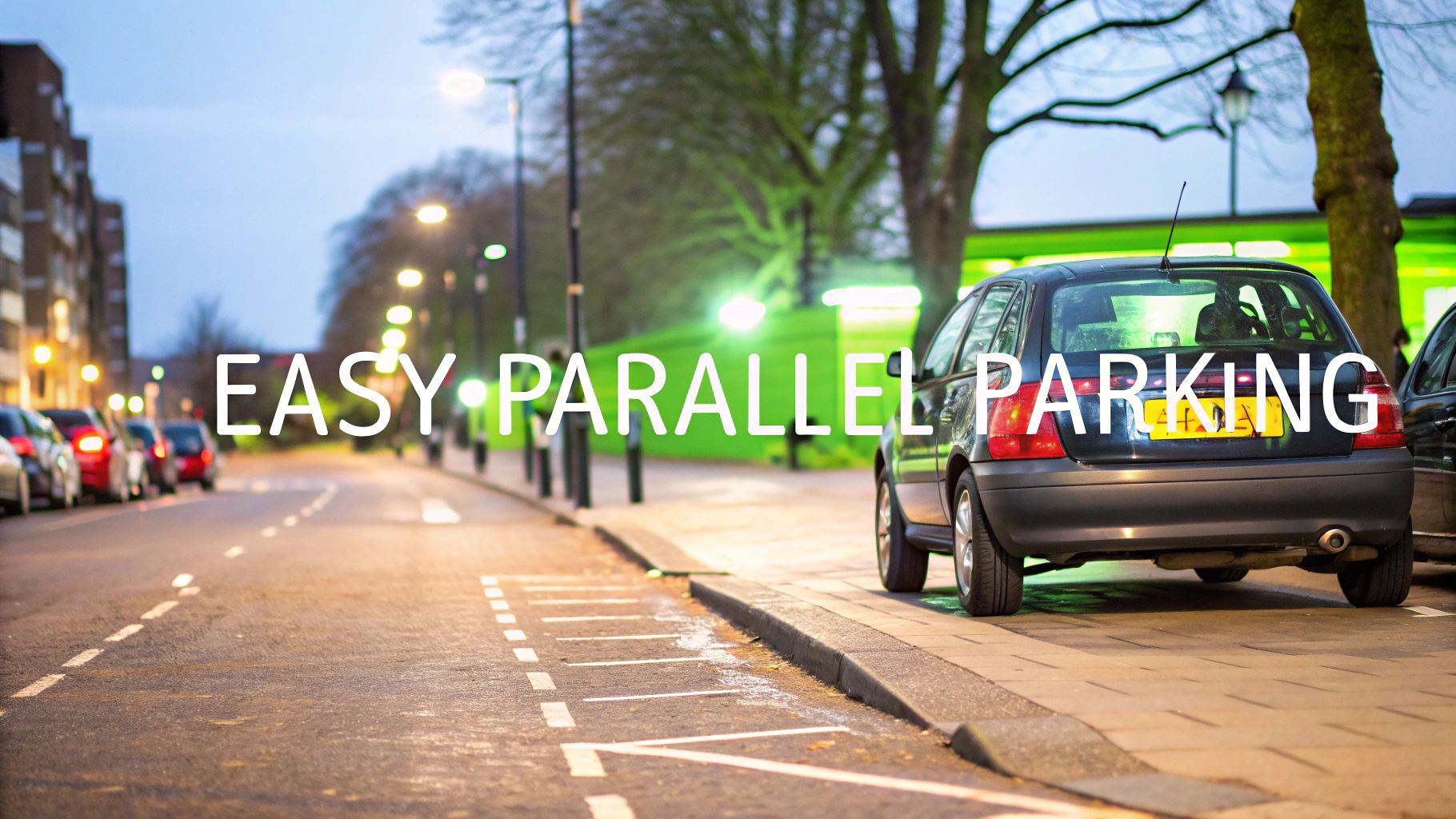Why Easy Parallel Parking Changes Everything for UK Drivers
For countless UK drivers, the very thought of parallel parking can spark a sense of unease. It's a manoeuvre frequently cited as the most challenging aspect of the driving test and often sidestepped long after the L-plates come off. But consider this: what if getting this one skill down pat could genuinely make your driving life much better? Learning easy parallel parking is about more than just squeezing into tight spaces; it’s about gaining a new sense of freedom and assurance behind the wheel.
The Real Impact of Parking Anxiety
This hesitation to parallel park isn't merely a small bother; it actively influences where and when many people opt to drive. Such apprehension frequently results in a self-imposed restriction on trips to city centres, bustling high streets, or residential zones where parking is limited. The pressure of locating a 'straightforward' spot, or the worry of delaying traffic while trying a difficult park, can easily detract from the pleasure of an outing.
Beyond the mental toll, consistently sidestepping this manoeuvre incurs real financial and time expenses. This is a common problem; although it's a standard component of UK driving tests, parallel parking, along with reverse bay parking, is among the most feared manoeuvres. A 2025 report indicated that 32% of UK drivers deliberately avoid these parking techniques. This avoidance isn't without repercussions, contributing to an average of 44 hours per year for each driver spent hunting for what they perceive as easier parking spots. This additional road time is estimated to cost £733 per driver each year in squandered time, fuel, and emissions—adding up to a considerable £23.3 billion nationwide. Explore further details on UK parking anxieties and their costs.
Unlocking Freedom and New Possibilities
On the flip side, mastering easy parallel parking can be truly liberating for motorists in the UK. Numerous drivers who've overcome their parking fears speak of a newfound confidence and a marked decrease in travel-related stress. They find they no longer have to circle blocks repeatedly or leave their car far from their intended destination.
Picture yourself smoothly guiding your car into that ideal space outside a lively city centre café, a convenient high street shop, or directly near a friend’s terraced home without a second thought. This capability is not just about convenience; it’s about getting back your time and achieving peace of mind. This skill translates to more options, reduced frustration, and an increased desire to explore.
Ultimately, overcoming this common driving hurdle with effective easy parallel parking methods opens doors to a broader array of opportunities for work, social activities, and personal journeys. The effort put into learning the correct technique offers benefits that go well beyond just finding a parking space; it improves your overall driving competence and liberty.
Understanding What Makes Parking Feel So Intimidating

Feeling a wave of relief after beating parking anxiety is a big win. But if you're aiming for truly easy parallel parking, it's useful to know why this specific move can seem so intimidating.
It’s not about being a bad driver; many motorists in the UK feel this unease when trying to fit their car into a snug spot by the kerb. Grasping this is the first step toward feeling genuinely sure of yourself.
The Psychology Behind Parking Nerves
Several elements contribute to the common nervousness people feel when trying to parallel park. For some, perfectionist tendencies are a major factor; the worry of not getting it perfect on the first try, especially with others watching, can be intense.
This is often made worse by the fear of public judgment – that uncomfortable sensation of delaying traffic or having an audience, turning a routine action into a stressful event.
If you've had a bad experience before, like a close call, a scratched wheel, or just a very tense try-out with impatient eyes on you, it can stick in your mind and make future tries feel even harder. It's no surprise that parallel parking is often called one of the most feared driving tasks by UK drivers.
A recent survey in the UK found that 43% of drivers listed it as their most disliked parking method. Even more telling, three-quarters (75%) of UK motorists admitted to giving up on a parking attempt because it was too difficult. You can explore more details about UK parking habits and challenges in this survey. This shows that achieving easy parallel parking is a common goal for many.
Why This Anxiety Lingers
This strong sense of unease isn't just for new drivers; it often stays with people who have been driving for years, and can even grow stronger. The task requires a tricky combination of steering, careful looking, and judging space, all while being out in the open.
For many, this means the stress doesn't completely go away, making consistent easy parallel parking feel out of reach.
Recognizing these mental challenges is the most important starting point for getting past them. When drivers admit these feelings, they can start to find ways to think differently and handle stress better when it happens.
For more on efficiently developing different driving abilities, you might find this guide on how to pick up driving skills quickly helpful. This kind of self-understanding is what builds real, long-lasting confidence when driving.
Your Complete Guide to Easy Parallel Parking Success
Let's be honest, many drivers in the UK find parallel parking a bit daunting. But what if it could be a straightforward skill? This guide offers a practical, step-by-step method specifically for UK roads, breaking down easy parallel parking into manageable actions. We're here to explain not just the steps, but the reasoning behind them, helping you turn this tricky manoeuvre into a confident part of your driving.
First things first: getting the initial setup right is key. Take a look at this image – it shows a car getting into position next to another parked vehicle on a standard UK street. This illustrates the very first, and arguably most important, stage.

Nailing this correct initial alignment really does make the rest of the parking manoeuvre much simpler. It’s all about giving yourself the best possible start for sliding smoothly into that space.
Key Reference Points for Easy Parallel Parking
So, what's the secret to consistent success with easy parallel parking? It often comes down to using reliable reference points. These are specific visual cues you can spot from your driver's seat, relating your car to the parking space or the car in front. They take the guesswork out of the equation, giving you clear signals for when to steer and when to stop.
To help you get these anchor points down, we've put together a handy table. It details these crucial markers and measurements specifically for parking on UK roads.
Easy Parallel Parking Reference Points for UK Roads
Essential visual markers and measurements for successful parallel parking
| Step | Reference Point | Action Required | Common Mistakes |
|---|---|---|---|
| 1. Initial Positioning | Space should be about 1.5x your car's length; align your rear bumper with the rear bumper of the car in front. | Pull up alongside the target car, keeping about 2-3 feet away. Don't forget to signal. | Starting too far away or too close; Incorrectly judging if the space is big enough. |
| 2. First Reverse & Turn | The middle of your car (often your B-pillar) lines up with the rear bumper of the target car. | Begin reversing slowly; steer one full turn towards the kerb. | Turning the wheel too early or too late; Forgetting to check your blind spots. |
| 3. Angling In | Your nearside wing mirror shows your car at an approximate 45-degree angle to the kerb. | Keep reversing steadily; use your nearside mirror to check how close you are to the kerb. | Hitting the kerb; Steering too much or not enough; Getting the angle wrong. |
| 4. Counter-Steer & Align | Your nearside front wheel is clear of the front car's bumper, OR you can see the entire car behind you in your offside mirror. | Steer fully away from the kerb; continue reversing until your car is parallel, aiming for 6-12 inches from the kerb. Straighten your wheels and adjust if necessary. | Turning away from the kerb too late; Finishing too far from or too close to the kerb. |
Getting familiar with these stages and their visual cues gives you a solid, repeatable method for parallel parking. While these points are great starting guidelines, remember that you might need to make small tweaks based on your car's size or the specific parking spot. Don't worry if you don't nail it on the first try – pulling forward to readjust is all part of the learning process.
Using Your Mirrors and Steering Effectively
Your car's mirrors are your best friends when it comes to easy parallel parking. They do more than just show you what’s behind; they're vital for judging distances and angles. Make it a habit to frequently check your nearside wing mirror – this is your main guide for watching your car’s angle and how close you are to the kerb. Your offside mirror and rear-view mirror are also important for keeping an eye on the car behind you and the overall space.
While many modern cars have backup cameras, which can be helpful, really learning to use your mirrors gives you much better control. When it comes to steering, aim for smooth and deliberate movements. The timing of your turns is much more important than how fast you turn the wheel.
Adapting to Real UK Road Conditions
Parking on UK streets often comes with its own set of challenges. Think narrow roads, cars parked tightly on both sides, and sometimes limited visibility. These situations make accurate initial positioning and the timing of your turns even more critical. For example, if you're on a busy, narrow street with traffic approaching, you'll need to be efficient and confident in your movements.
Smaller cars might find achieving that 45-degree angle a bit easier, whereas larger vehicles such as SUVs or vans will require a bit more awareness of their turning circle and larger blind spots. No matter your vehicle, always put safety first: signal your intentions clearly, and don't rush, particularly when you're still getting the hang of it. If you're looking to brush up on other driving skills, you might find our guide on mastering various driving test manoeuvres helpful.
By following this methodical approach, focusing on those key reference points and timely actions, parallel parking can become much less of a mystery. With a bit of practice, it can become a driving skill you use with confidence every day.
Fixing The Mistakes That Keep You Stuck
Even when you have a solid understanding of the steps for easy parallel parking, things can still go awry. Mistakes happen to everyone, whether you're just learning or have been driving for years. Recognizing these frequent errors is the first step to fixing them efficiently, making this often-dreaded maneuver a less daunting task.
Starting Position Problems
A common hurdle many drivers face is the initial setup. Beginning either too close to the car you're parking behind, or conversely too far away, can compromise all your following moves. This often results from being hurried or incorrectly gauging the crucial 2-3 feet gap needed to begin.
To address this, spend an additional moment ensuring proper alignment. Make certain your vehicle is parallel and at the correct distance before starting to reverse. Adjusting your starting position is much simpler than trying to recover from an incorrect initial placement.
Misjudging Crucial Turning Points
Incorrectly timing your steering wheel turns is another frequent problem. Turning the steering wheel too early can result in your car hitting or mounting the kerb. Conversely, turning too late might mean you cannot fit into the space or you end up positioned too far from the kerb.
This is where your chosen reference points are particularly helpful. Move slowly and continually verify your car's position relative to these markers. If you feel uncertain, pausing to re-evaluate is a much better choice than risking damage to your wheels.
Kerb Anxiety and Contact Errors
Worrying about striking the kerb, or another car, contributes significantly to parking anxiety for many drivers in the UK. This apprehension is not limited to new drivers; many experienced motorists also find parallel parking difficult. Indeed, research shows that nearly a quarter (23%) of drivers confess to bumping another vehicle while parking, and 33% have caused damage to a wheel or tyre in the process. Find more detailed statistics on UK parking incidents here.
Such incidents frequently arise from underestimating the car's rear movement or the distance to the kerb. Paying close attention to your nearside mirror to monitor your rear wheel's proximity to the kerb is essential for prevention. Smooth, measured movements are vital for staying in control and completing the park successfully.
Knowing When to Pull Forward and Readjust
There are times when, no matter how carefully you proceed, the car isn't positioning itself correctly. The natural tendency might be to persist in trying to fit into the spot. However, often the wisest course of action is to pull out and try again. If you find yourself at a bad angle or uncomfortably close to another object, don't be afraid to pull forward, straighten your vehicle, and either restart the entire maneuver or just the part that went wrong.
Understanding when minor corrections are insufficient and a complete reset is necessary is a sign of good driving judgment. This method can save time, lessen frustration, and most importantly, help avoid damage to your car or others. Consider it a brief restart in your journey to proficient parallel parking.
Keep in mind that every error offers a chance to learn. Each attempt that doesn't go perfectly provides useful insights, assisting you in improving your judgment and skills for future efforts. With ongoing practice and these solutions, difficult parking spots will eventually become a standard part of your driving.
How Different Generations Approach Parking Challenges

Stress related to parking, especially when it comes to actions like parallel parking, shows up differently among various age groups in the UK. These distinct comfort levels provide useful information on how driving background, reliance on vehicle technology, and early driving instruction have influenced attitudes towards achieving easy parallel parking. Recognizing these generational differences is quite insightful.
Shifting Skills and Stress Levels
Driving instructors throughout the UK observe clear trends. Older drivers, for example, often learned when cars had minimal assistance, which may have built a greater dependence on their own manual abilities. Conversely, younger drivers frequently grew up with parking sensors and cameras as common car features, affecting their self-assurance when these tools aren't available or when they need to perform easy parallel parking by hand.
Recent data certainly points to a considerable generational difference in both parking capabilities and nervousness in the UK. For example, a 2025 survey found that a remarkable two-thirds (around 66%) of drivers between 18 and 28 years old—a group often known as Gen Z—acknowledged asking parents or friends to park their car nearly every time they faced a difficult spot. For these younger drivers, the anxiety is so pronounced that 96% reported feeling stress due to parking. Learn more about this parking trend across generations.
Impact on Independence and Confidence
This increasing dependence on others for assistance, particularly when attempting easy parallel parking, understandably brings up questions about developing lasting independent parking abilities. Although technology provides convenience, a solid grasp of spatial judgment and car handling is still vital for managing any parking scenario with confidence.
Moreover, variations between generations in areas such as willingness to take risks and the desire for perfection can affect how confident people feel about parking. Some drivers are more inclined to try parking even if it's challenging, whereas others might experience strong pressure to execute the move perfectly, which increases their stress. This need for a flawless performance can sometimes get in the way of regularly achieving easy parallel parking. Understanding these different outlooks is helpful for identifying useful approaches for all drivers.
Smart Technology That Actually Helps Your Parking
Today's cars often include technology aimed at taking the stress out of difficult driving situations, which can be a real asset when you're trying for easy parallel parking. While many drivers welcome these features, using them well is crucial. The goal is for these aids to enhance your fundamental driving skills, not to let those skills fade.
Parking Aids: Your Electronic Co-Pilots
You'll find parking sensors in many UK cars. They work by giving you sound alerts or visual cues on a display, letting you know how close you are to objects such as another vehicle or a short wall. These warnings usually get stronger the nearer you get, giving you a good sense of the space around you.
But, they're not perfect; sensors might not pick up slender poles or very low objects. So, it's wise to use them alongside your own thorough checks, not instead of them.
Then there are reversing cameras. These project an image of what's behind your car onto a screen on your dashboard. This is incredibly useful for easy parallel parking, especially when space is limited, offering a view that mirrors alone might not provide.
The main thing to watch out for is becoming too reliant on them, as this could mean you use your mirrors less and your spatial awareness doesn't develop as well. Think of cameras as an extra pair of eyes, supporting your own checks, rather than your main tool for seeing. This way, you keep your fundamental driving skills sharp.
The Rise of Automated Parking Systems
Some more recent cars come with automated parking systems. These clever systems can actually take over the steering to maneuver your car into a parking space. For those tricky parallel parks, especially in confined areas, this might sound like the perfect solution for easy parallel parking.
But, it's really important not to view them as a way to avoid learning to park yourself. They are best seen as sophisticated aids for particular situations, not a replacement for the confidence that comes from being able to park any car on your own.
Ultimately, these smart features serve best as training aids, working alongside your own driving abilities. They can certainly help you understand spacing and angles better. However, genuine confidence in achieving easy parallel parking develops when you combine the help from technology with your own well-practiced judgment.
Striking this balance is what helps you grow into a well-rounded driver, comfortable parking your car whether you have electronic assistance or not.
Building Parking Confidence That Lasts
Understanding the mechanics of easy parallel parking is a good start, but genuine mastery stems from building a robust, lasting confidence. This isn't just about executing the sequence of actions; it’s about developing a durable self-assurance through consistent practice and a positive mental approach. This deep-seated confidence transforms parallel parking from a feared challenge into a routine part of driving.
Strategic Practice for Long-Term Skill
The cornerstone of enduring parking confidence is strategic practice. It’s less about the sheer volume of practice and more about the quality and approach. Your initial move should be to find appropriate, safe practice areas. Across the UK, good options include quiet industrial estates on weekend mornings or spacious, empty supermarket car parks during off-peak times. These locations let you concentrate without the stress of traffic or observation.
This kind of focused repetition in low-pressure settings helps you build essential muscle memory. This is the process by which your body internalizes the sequence of actions – steering adjustments, reversing, and mirror checks – until they feel almost second nature. For instance, the precise feel of the steering wheel during that first turn towards the curb will eventually become intuitive. Such automatic responses are vital for executing easy parallel parking competently when it counts.
Setting Goals and Embracing Setbacks
To ensure your practice remains productive and encouraging, it’s beneficial to set realistic progress goals. Your initial aim might be as simple as guiding the car into a wide space between two markers, without undue concern for perfect positioning. As your abilities grow, you can progressively challenge yourself with narrower spots or more active surroundings.
Equally important is learning to turn setbacks into learning opportunities. It's natural that not every parking attempt will be flawless. Rather than feeling discouraged, take a moment to analyze what didn't go as planned. Were you positioned too near the vehicle ahead? Was your steering input delayed? Grasping these details is key to refining your technique. Developing mental resilience plays a significant role here; if parking anxiety is an issue, you might find helpful advice in our piece on how to manage driving test nerves. Adopting this perspective prepares you to confidently face more demanding parking situations.
To help organize your skill development, a structured, step-by-step plan can be very effective. Below is a suggested schedule to guide your practice sessions.
Progressive Easy Parallel Parking Practice Schedule
Structured approach to building parallel parking confidence over time
| Week | Practice Focus | Duration | Success Metrics |
|---|---|---|---|
| 1-2 | Quiet area, large space, no kerb pressure | 15-20 mins, 3x | Consistently getting within the space, smooth initial turn |
| 3-4 | Standard space (1.5x car length), with kerb | 20-25 mins, 3x | Good kerb distance (6-12 inches), fewer corrections |
| 5-6 | Tighter spaces, between two actual cars (if safe) | 20-25 mins, 2x | Confident execution, accurate judgment of car's corners |
| 7+ | Varying conditions, slight inclines, busier roads | As opportunities arise | Consistent success, minimal stress |
This progressive plan allows you to build your skills systematically, moving from simpler scenarios to more complex ones as your comfort and ability increase.
Maintaining Your Edge
After you have developed your skills and confidence, the next important step is maintenance. Even if daily parallel parking isn't part of your routine, seize opportunities as they come to keep your abilities honed. Casually tracking your advancements and recognizing your achievements can also serve as a powerful motivator.
Ultimately, achieving easy parallel parking is a journey of converting focused practice into an ingrained habit, and transforming initial nervousness into real competence. Through steady effort and effective strategies, you can ensure this driving skill becomes a dependable asset in your driving repertoire for the long haul.
Ready to build your driving confidence with structured, expert guidance? Fast Pass Driving Courses provides intensive programs across the UK designed to help you master skills such as parallel parking and pass your test efficiently. Find your ideal course today at Fast Pass Driving Courses and accelerate your journey to driving success!

